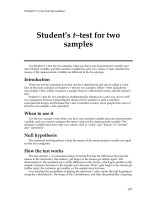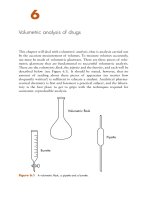Ebook A-Z of abdominal radiology (1st edition): Part 2
Bạn đang xem bản rút gọn của tài liệu. Xem và tải ngay bản đầy đủ của tài liệu tại đây (8.65 MB, 214 trang )
E
A to Z of Abdominal Radiology
138
Endometrial carcinoma
• Endometrial carcinoma is the most prevalent female cancer of the
genital tract and 4th most prevalent cancer in women.
• Adenocarcinoma make up 90–95%.
• Tumours of epithelial and mesenchymal origin (sarcomata) form
5–10%; such as Leiomyosarcoma, malignant mixed müllerian tumours,
adenosarcomas, gestational trophoblastic tumours.
• Incidence in UK is 4900 per annum, 990 deaths annually.
• Disease of postmenopausal women; peak age 55–62 years, 75% over the
age of 50 years.
• Risk factors:
• exposure to unopposed oestrogens, such as extrinsic oestrogen therapy and tamoxifen, is common risk.
• obesity.
• nulliparity.
• ovarian malfunction in polycystic ovaries.
• late menopause.
• Other associations are:
• diabetes mellitus.
• smoking.
• hypertension.
• association with breast cancer.
• 90% arise within uterine epithelium: 90% of these are well-differentiated
adenocarcinoma (grade I).
• Endometrial cancer arises in the glandular component of endometrial
epithelium.
• Grows as a polypoid mass within the endometrial cavity, producing
ulceration and vaginal bleeding.
• Spread is by:
• direct invasion of the myometrium and extension through to the
serosa.
• direct invasion of parametrium with serosal seeding.
• direct extension down endocervical canal.
• Uterus has a rich blood and lymphatic supply, a common route of
spread.
• Lymph node and haematogeneous metastases are common:
• upper uterine body tumours spread to common iliac and para-aortic
nodes.
• mid and lower uterine body tumours spread to parametrial, paracervical and obturator nodes.
• metastases via round ligament and vaginal extension produce inguinal
adenopathy.
• Distant spread is to bone, lungs, liver and brain.
E
Endometrial carcinoma
Endometrial carcinoma. TA US of the pelvis demonstrating abnormal
endometrial thickening (arrow). Asterisk indicates the bladder.
Endometrial carcinoma. TV US of the pelvis demonstrating abnormal
endometrial thickening (arrow/calipers). Asterisk indicates the body of
uterus.
Clinical characteristics
• Usually presents with intermenstrual/postmenopausal vaginal bleeding.
• Occasionally in advanced disease, presents with sequelae of distant
spread to target organs or peritoneum.
• Rarely presents with an abdominal (uterine) mass.
139
E
A to Z of Abdominal Radiology
140
Radiological features
• FIGO classification used to stage uterine cancer:
Stage I: tumour confined to endometrium or myometrium (A–C).
Stage II: invasion of cervix (A–B).
Stage III: invasion of serosa, adnexae (A) or vagina (B) with nodal
metastases (IIIC).
Stage IV: invasion of bladder/bowel (IVA) or distant metastases (IVB).
• Depth of myometrial invasion is the most important prognostic factor:
incidence of nodal mestastases rises from 3% (stage IB) to 40% (stage IC).
• TV US, CT and MRI are all capable of assessing myometrial invasion.
• Early endometrial disease best assessed by direct visualisation and biopsy.
• Cross-sectional imaging best for more advanced disease.
• USS (TV/TA):
• TV/US in the preferred modality due to greater sensitivity.
• Increase in endometrial thickness >5mm, usually echogenic, irregular poorly defined boundary.
• Myometrial invasion demonstrated as disruption of the normally
smooth interface between the endometrium and myometrium.
• Depth of invasion assessed by proportion of myometrium occupied
by echogenic tumour.
• Accuracy is 77–91%.
• Cervical involvement often detected.
• Usually superior to CT, equivalent to MRI for myometrial invasion
assessment.
• Extra-uterine and nodal spread not accurately determined.
• Diagnostic value of Doppler blood flow measurements is
controversial.
• CECT:
• Demonstrates endometrial tumour as a hypodense mass in the endometrial cavity or myometrium, or fluid-filled uterus caused by
endocervical canal obstruction by the tumour. Not used for local
staging.
• Capable of detecting deep myometrial invasion.
• May show cervical extension but less accurate than TV US or MRI.
• Accuracy of 58–76%.
• Often cannot differentiate from benign uterine masses, so less useful
in early disease.
• Most useful for advanced disease and detection of distant metastases,
pelvic extension and nodal mestastases.
• MRI:
• Excellent for local staging.
• Widening or heterogeneity of signal within endometrial canal may be
only sign in stage IA carcinoma (confined to endometrium).
• Endometrial tumour has lower signal than endometrium, and higher
signal than myometrium.
(A)
(B)
E
Endometrial carcinoma
Endometrial carcinoma. Axial (A) and sagittal (B) T1 MRI of the pelvis
after intravenous contrast. Abnormal enhancing soft tissue is seen
expanding the endometrial cavity (asterisk). The body of uterus is markedly
thinned (arrow). B, bladder.
• Disruption or absence of junctional zone implies myometrial invasion; however, junctional zone may not be visible in some postmenopausal women.
• Myometrial invasion shown as areas of relatively high signal within
the low-signal myometrium.
• Contrast-enhanced T1W images clearly define zonal anatomy and
improve accuracy.
• Endometrial cancer enhances more slowly than endometrium (bright
on T1W) or myometrium (dark on T1W).
• Relationship of tumour to cervix is important prognostically.
• Multiple planes used to assess both longitudinal and radial tumour
spread.
• Cervical epithelium is hyperintense on T2W and late post-gadolinium
T1W images; disrupted in cervical extension.
• MRI is superior to TV US and CT in predicting cervical stromal invasion.
• MRI is inferior to hysteroscopy in detecting mucosal involvement.
• Overall sensitivity of MRI is 82–94% in detecting deep myometrial
invasion.
141
F
Familial polyposis coli
A to Z of Abdominal Radiology
Clinical characteristics
• An autosomal dominant condition with 80% penetrance that is characterised by a myriad of (~1000) colonic adenomatous polyps.
• The polyps develop at the age of puberty.
• Symptoms include vague abdominal pain, bloody diarrhoea and
protein-losing enteropathy.
• The main complication is malignant transformation. By 20 years following diagnosis, almost 100% will have developed colonic carcinoma.
There is also a lesser increase in the incidence of gastric and small-bowel
malignancy.
• The treatment is total colectomy in the late teens or early twenties.
Radiological features
• Generally now diagnosed in family members by colonoscopy, but
sporadic cases may present at barium enema with a myriad of small
polyps forming a ‘carpet’ throughout the colon. There may be evidence
of carcinoma, often with more than one synchronous tumour.
• CT colonography can reliably detect polyps of 5mm and smaller but
represents a significant radiation dose in patients who are usually in their
teens at the time of investigation.
142
F
Familial polyposis coli
Familial polyposis coli. The colon is ‘carpeted’ in multiple small polyps.
Familial polyposis coli (same patient; enlarged view of the sigmoid
colon). Multiple polyps are clearly evident (arrowheads).
143
F
A to Z of Abdominal Radiology
144
Fistulae
Clinical characteristics
• A fistula is an abnormal communication between two epithelialised
surfaces. Examples include biliary-enteric, entero-cutaneous, aortoenteric, entero-vesical, ano-rectal, vesico-colic.
• The causes include trauma, surgical complication, infection and inflammation, for example secondary to inflammatory bowel disease and
diverticular disease.
• Clinical presentation will depend on the type of fistula.
F
Fistulae
Vesico-vaginal fistula. Film from an IVU series. Contrast within the
bladder (asterisk) is seen within the vaginal vault (arrow).
Colo-vesical fistula. Barium enema decubitus film (left side down) shows
diverticular stricture (arrowhead) and an air–barium level within the
bladder (arrows).
145
F
A to Z of Abdominal Radiology
146
Radiological features
• Imaging of a fistula is aimed at identifying its exact path and any
underlying disease to aid surgical repair.
• AXR:
• Plain radiography generally is not helpful in diagnosing fistulae.
• Fluoroscopy following the instillation of iodinated contrast into a
cutaneous fistula (fistulogram) can be useful to demonstrate the tract.
• Barium: similarly barium in the bowel, either as a small bowel followthrough or barium enema, or water-soluble contrast in the bladder as a
cystogram, may be used to demonstrate a fistula.
• Nonetheless, it is important to be aware that the fistulous tract may be
very small and, therefore, difficult to see on these studies.
• Despite this, such studies may be of use in delineating the extent of
underlying bowel disease.
(A)
F
Fistulae
(B)
Aorto-enteric fistula. Axial CT before (A) and after (B) contrast. On
the unenhanced scan, a small pocket of gas is seen along the anterior wall
of the aortic graft (arrow), caused by infection. Following contrast,
enhancement is seen within several small bowel loops (asterisk) from a fistula.
147
F
A to Z of Abdominal Radiology
148
• US, CT and MRI:
• All these modalities may be of use in imaging fistulae.
• A mass may be seen associated with the fistula, particularly when it is
caused by an inflammatory condition such as diverticular disease or
inflammatory bowel disease.
• The tract may also be visible.
• Air may be seen within the bladder in a colo-vesical fistula.
• Usually CT is the most useful of these cross-sectional modalities.
• Angiography:
• Angiography may be necessary to help to diagnose an aorto-enteric
fistula between the aorta and bowel, most commonly the third or
fourth part of the duodenum.
• This usually occurs in a patient with a preexisting aortic graft who
presents with an upper GI bleed, pain or a pulsatile mass.
• Alternatively, an aorto-enteric fistula may be investigated with CT
pre- and postcontrast.
F
Fistulae
Entero-cutaneous fistula. Fistulogram where contrast is injected via a
cannula though the cutaneous ostium (arrow) demonstrates a fistula to both
small bowel and caecum (arrowheads). Note the presence of an IVC filter
adjacent to the L3 vertebral body.
149
F
A to Z of Abdominal Radiology
150
Foreign bodies
Clinical characteristics
• Foreign bodies may appear in abdominal imaging following trauma,
iatrogenic intervention, and patient ingestion or insertion – either
intentionally or accidentally.
• There is a wide range of presentation, ranging from asymptomatic to in
extremis.
• Children tend to swallow coins, marbles, disc batteries and crayons.
• Adults tend to swallow dentures, chicken and fish bones or may obstruct
on a food bolus.
• Bizarre ingestions are more likely with psychiatric patients and a subgroup of prison inmates.
• Within the oesophagus there are three points of narrowing where a
foreign body is likely to impact: the cricopharyngeus, at the level of the
aortic arch and at the lower oesophageal sphincter.
• Once a foreign body has passed in to the stomach, there is an 80–90%
chance of it passing through the GI tract.
• The main obstacle to passage through the small bowel is the ileocaecal
valve.
• Complications include laceration, perforation, associated peritonitis,
abscess formation and infection. Disc batteries may cause oesophageal
erosion.
F
Foreign bodies
Foreign body. Swallowed screw within the stomach (arrow).
Foreign body. Swallowed coin within the stomach (arrow).
151
F
A to Z of Abdominal Radiology
152
Radiological features of ingested foreign bodies
• The imaging of an ingested foreign body consists of a CXR to assess
whether the body lies in the oesophagus.
• In children, this should include the neck.
• For fish and chicken bones, a soft tissue lateral radiograph of the neck is
indicated.
• In adults, a lateral CXR may also be needed if the frontal radiograph is
negative.
• If the foreign body has passed into the stomach, the patient can be
reassured.
• Generally, AXR is not justified because of radiation dose. Two exceptions are singestion of sharp or poisonous objects, such as open safety
pins or batteries.
F
Foreign bodies
Foreign body. Retained forceps following a laparotomy.
Foreign body. Mercury thermometer deliberately inserted into the
bladder.
153
F
A to Z of Abdominal Radiology
154
Radiological features of iatrogenic/inserted
and incidental foreign bodies
• AXR:
• Detects radioopaque foreign bodies, such as metallic materials and
some types of glass.
• Can be useful for checking the position of medical devices, for
example the ‘lost IUCD’, as well as screening postoperative patients
when a surgical item is unaccounted for.
• If an unexpected foreign body is found, always consider that it may be
within the patient’s clothes.
• Remember not all foreign bodies are radioopaque, for example
wood.
• USS: initial investigation for checking whether an IUCD is within the
endometrial cavity, thereby avoiding the radiation dose of an AXR.
• CT: useful for assessing secondary complications of foreign bodies.
F
Foreign bodies
Foreign body. Retained surgical swab (arrow).
Foreign body. Large rectal foreign body.
155
F
Free intra-abdominal gas
A to Z of Abdominal Radiology
Pneumoperitoneum
Clinical characteristics
• The aetiology of pneumoperitoneum includes perforation of a hollow
viscus, through trauma, iatrogenic intervention or from inherent bowel
disease, such as a perforated ulcer. Other causes include gas entering via
the peritoneal surface, such as trans-abdominal biopsy or catheter placement, and via the female genital tract.
• Gas-forming peritonitis or the rupture of a gas-filled intraperitoneal
abscess can also lead to a pneumoperitoneum.
• Postoperative gas takes a variable amount of time to disappear but if it
remains for more than 3 days consider ongoing gas leakage.
Radiological features
• Erect CXR:
• Small amounts of free gas are generally seen first in the RUQ as a
single area of radiolucency lying between the right hemidiaphragm
and the liver.
• Volumes as small as 2ml may be identified.
• Gas may also be seen under the left hemidiaphragm.
• Be aware that the patient should be in the erect position for at least
5min before the CXR is taken to allow free gas to accumulate under
the diaphragm.
• Decubitus AXR:
• On occasion, the patient may not be able to maintain an erect
position for long enough, in which case a left lateral decubitus
AXR (left side down) can be helpful.
• In this position, free gas will lie between the lateral aspect of the liver
and the diaphragm.
156
F
Free intra-abdominal gas
Free air under the diaphragm (asterisk).
Free intra-abdominal air (Supine AXR). Note Rigler’s sign (arrowheads).
157
F
A to Z of Abdominal Radiology
158
• AXR:
• The supine AXR can demonstrate free gas, although greater quantities are usually needed than with the erect CXR.
• Free gas against a soft tissue surface will outline that tissue more clearly
than usually seen on AXR: structures so outlined include the falciform ligament, the liver edge, the umbilical ligaments and diaphragmatic slips.
• “Riggler’s sign” (the double-wall) sign represents air within the bowel
lumen outlining the inner surface, while free air outlines the outer wall.
• Plain film pitfalls include Chilaiditi’s syndrome, subdiaphragmatic fat,
adjacent gas-filled bowel loops simulating Riggler’s sign, subdiaphragmatic abscess, and diverticula of the stomach or duodenum.
• CT:
• This is very sensitive for detecting free gas, but the radiation dose
involved means that plain films remain the mainstay investigation.
• On CT, areas of gas need to be carefully examined to establish
whether they represent free or bowel gas.
• May demonstrate likely site of perforation.
• USS: much less sensitive than the above techniques as differentiating
free air from bowel gas is difficult.
F
Free intra-abdominal gas
Pneumoperitoneum. Left lateral decubitus film. Note the presence
of free air (arrow) between the lateral margin of the liver (L) and the rib
cage.
Pneumoperitoneum. Free air anterior to the liver (asterisk).
159
F
A to Z of Abdominal Radiology
160
Pneumoretroperitoneum
Clinical characteristics
• Can be caused by duodenal perforation or trauma, urinary tract gas,
pancreatic abscesses or gas tracking down from a pneumomediastinum.
Radiological features
• AXR: the presence of gas in the retropertioneum may sharply outline
the kidney and psoas muscle, and streaks of gas may outline the muscle
bundles.
F
Free intra-abdominal gas
Peritoneal air (Supine AXR). Extensive intraperitoneal (asterisk) and
retroperitoneal free air following ERCP. Note a biliary stent in situ (black
arrowhead). The inferior margin of the liver is outlined in the intraperitoneal
compartment (white arrowhead), with the kidneys (arrows) and psoas
muscles (curved arrow) outlined in the retroperitoneal compartment.
Pneumoretroperitoneum. Free air within the retroperitoneum (arrows).
161
G
Gallstones
A to Z of Abdominal Radiology
Clinical characteristics
• Gallstones are common, affecting 10–20% of the population.
• Two main components are cholesterol and calcium bilirubinate
• There are three types of gallstone, based on their components: cholesterol, pigment and mixed, of which mixed is the most common type.
• Cholesterol stones are caused by precipitation of supersaturated bile
and occur in the Western population.
• Pigment stones occur from excessive haemolysis, resulting in excess
unconjugated bilirubin and hence precipitation of calcium
bilirubinate.
• Gallstones may be present for decades without causing symptoms or
complications, and usually do not require any treatment.
• Biliary colic is the result of a gallstone impacting within the cystic duct
during gallbladder contraction, which then eases as the gallbladder
relaxes and the stone dislodges. The pain localizes to the RUQ and
epigastrium.
• Acute cholecystitis occurs when persistent obstruction of the cystic duct
causes gallbladder distension and inflammation. This may progress to
pus collecting within the gallbladder, known as an empyema. If the
gallbladder perforates, a pericholecystic abscess may form.
• Chronic cholecystitis occurs in the setting of long-standing gallstones
and results in a shrunken gallbladder with loss of function.
• Gallbladder adenocarcinoma occurs in patients with gallstones, but gallstones are
not carcinogenic per se.
Radiological features
• AXR: 30% of gallstones are calcified and 10% are visible on AXR. This
is usually an incidental finding rather than a diagnostic one, owing to the
high false-negative rate.
• USS:
• The most important modality for imaging gallstones and their
complications.
• Patients must be fasted to avoid gallbladder contraction, thereby
reducing false-negative investigations.
• Gallstones appear as echogenic foci, with posterior acoustic shadowing, that move within the gallbladder when the patient is turned.
162









